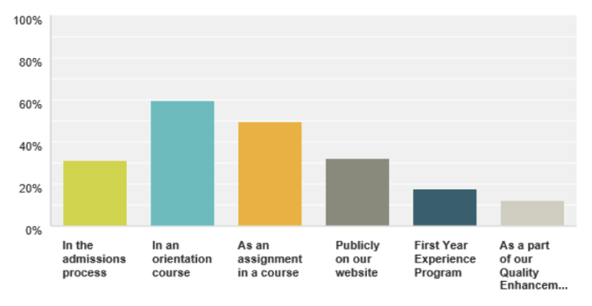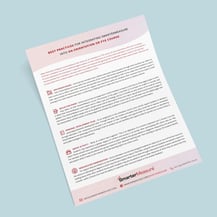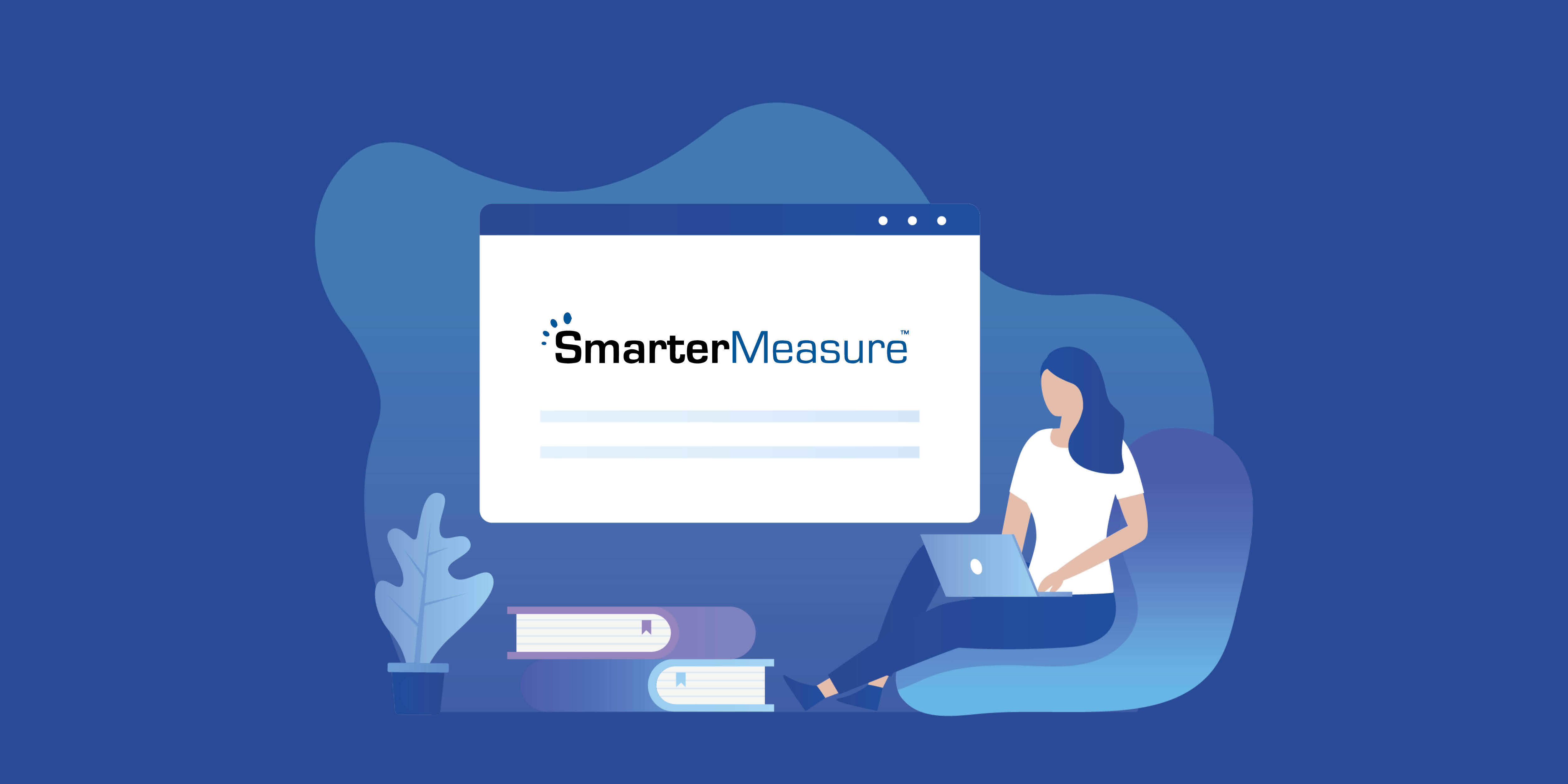
SmarterServices does not dictate how schools can use SmarterMeasure. Schools decide on the place or places within the student experience that best fits their need. We periodically survey clients asking them where they position the assessments. As is shown on this graphic of survey results, orientation courses, academic courses, and the admissions process are common places where learner readiness is measured.

Another place for which there is strong research support, which I will be sharing with you in this blog, is in a First-Year Experience (FYE) program or course.
To learn more, watch this video for information, tips, and examples on how your institution can incorporate SmarterMeasure in your institution's FYE program.
Don't want to watch the video? Check out the video summary below.

Video Summary:
What are First-Year Experience (FYE) Programs?
FYE programs typically provide practical experiences such as campus tours, test-taking strategies, study tips, and information about different majors. FYE programs often foster the participation of students in co-curricular events such as common reads, concerts, art exhibits, and guest lectures. In addition to helping the student get to know their school and its services, FYE programs also often foster self-awareness by using assessments to help students understand their own strengths and opportunities for growth.
Over the past 20 years, the SmarterMeasure Learning Readiness Indicator has been the leading assessment for quantifying the traits, attributes, skills, and habits that students need to be successful. During this period of time, many schools have used the assessment in their FYE programs. Through our communications with clients including integration surveys, we have compiled this partial listing of schools that at some point have utilized SmarterMeasure in a First-Year Experience program:
|
|
Key Challenges for New Students During the Pandemic
While there has always been a need for an FYE program, that need has never been greater than now during the pandemic. Inside Higher Ed published an article titled First-Year Students Struggled With Online Learning Last Year. While it has always been the case that distance learning is a better fit for some students than others, during the pandemic the vast majority of college students were forced to study online. This proved especially difficult for students who were not only new to college-level learning but also had to do it through a new online delivery system.
The article named three key factors that created learning challenges for students:
- Lack of access to technology and the internet
- A gap in learning resources (such as instructor feedback, structured course materials, and opportunities for collaboration)
- Limited prior experience with online learning
Commenting in this article, Janet Godwin, CEO of ACT, stated, “The past academic year was perhaps the most challenging year in the lives of American college students, particularly students from low-income families and first-generation college students, who were more likely to have limited access to technology and the internet compared to their counterparts.”
The article cited research that found that “82 percent of students were “a great deal” or “somewhat” concerned that online learning during the pandemic would negatively impact their academic success this year.”
Relevant Dissertations
But even prior to the pandemic underscoring the need for new students to be trained in how to study online, there was a substantial body of literature justifying the need to measure and respond to learner readiness in a program like an FYE course. These three dissertations explored the phenomenon.
1. Dr. Naomi DeWinter, Ferris State University, Effects of a First-Year Course on Motivation/Grit and Selected Student Attitudes
Dr. Naomi DeWinter’s research concluded that there is a relationship between non-cognitive variables (you might think of them as grit), and academic success. Her study stated, “The qualitative analyses demonstrated many positive gains from the FYE course including interdependence, use of college resources, focus on career goals, and social integration. While taking the FYE course did not result in a statistically significant difference in means in a pre/post model, significant correlations existed for first semester GPA and increase in Individual Attributes and Locus of Control.”
2. Dr. Malinda Mansfield, Walden University, The Impact of the Digital Divide on First-Year Community College Students
Malinda Mansfield’s dissertation research recommended that assessments like SmarterMeasure be used in FYE programs to measure computer literacy. She stated, “The findings of this study prompted a recommendation to change the student entrance policy to include student computer literacy workshops and placement exams. This study impacted positive social change by providing information to educators at the study site as to the computer literacy and LMS skills that are needed in a FYE course.” SmarterMeasure quantifies both computer literacy and LMS skills.
3. Dr. Melanie Clark, University of North Florida, Student Success and Retention: Critical Factors for Success in the Online Environment
In her dissertation, Melanie Clark found that in addition to demographic variables, non-cognitive learner variables measured by SmarterMeasure did have a relationship with end of course grades stating “the findings regarding the assessment variables suggest that students who are better equipped and prepared in the readiness factors assessed may have slightly higher grades as well.”
Published Research and Case Studies
In addition to these dissertations, other published research and case studies also justify the use of SmarterMeasure in FYE programs.
1. Shaw, Burris and Ferguson, "Factors That Influence Student Attrition in Online Courses" Online Journal of Distance Learning Administration
In a research article published in the Online Journal of Distance Learning Administration titled “Factors That Influence Student Attrition in Online Courses”, Shaw, Burris, and Ferguson concluded that, “Results demonstrated that verbal and physical learning styles and personal attributes such as procrastination increase the likelihood for attrition, while clear reasons for pursuing a degree and typing skills decrease the likelihood for attrition. Outreach to identified at-risk students did promote greater levels of student success and persistence.”
2. The University of North Georgia, Case Study on the use of SmarterMeasure
A case study at the University of North Georgia documented that among their first-year students administering SmarterMeasure followed by targeted supports, resulting in better grades. The study states, “UNG Online compared the online grades of those who completed SmarterMeasure against those who had not. The results of this comparison revealed, with 95% confidence, that the online grades of those who had taken the assessment were, in fact, significantly higher (average GPA of 2.87), than the grades of those who had not taken the assessment (average GPA 2.44). This result was especially compelling when UNG Online determined no statistical significance between the previous grade point averages of the two groups prior to UNG enrollment. The compelling difference, therefore, appears to be the targeted supports put in place based on intelligence yielded from the SmarterMeasure results.”
High-Impact Assignments for the First-Year Seminar
Dr. Joe Cuseo, Professor Emeritus of Psychology at Marymount California University, is a recognized authority on all things related to FYE programs. In an article titled, “High-Impact Assignments for the First-Year Seminar” he supported using an assessment like SmarterMeasure. He stated:
Assignments designed to promote self-assessment and self-awareness are highly consistent with the student-centered focus of the first-year seminar and provide students with information about themselves that they can use proactively to guide decisions they will make with respect to their education, profession, and other life choices they will make in college and beyond. These types of assignments also encourage students to engage students in two important lifelong learning habits: personal reflection and self-examination.
In his seminal research article titled The Empirical Case for the First-Year Seminar: Evidence of Course Impact on Student Retention, Persistence to Graduation, and Academic Achievement, Joe stated, “National research suggests that holistic first-year seminars have the most significant impact on student outcomes. Collectively, these findings and observations point strongly to the conclusion that first-year seminars should move beyond just cognitive and academic-skill development to address development of the student as a 'whole person.'”
Lone Star College Analysis of SmarterMeasure
Finally, some of our own research which was conducted for Lone Star College, which was an analysis of the distribution of their student’s SmarterMeasure scores, revealed that first-generation college students are at a much higher risk of not being prepared for college. The report concluded, “For all five scales (Life Factors, Individual Attributes, Reading Recall, Technical Competency, and Technical Knowledge) there was a higher percentage of first-gen students who were identified as being at a low level of readiness. Also, for four of the five scales, there was a lower percentage of first-gen students who were identified as being at a high level of readiness. This leads to a strong conclusion that is supported by much other research that first-generation college students are at higher risk than those who are not.” For this reason, the combination of a well-designed FYE program of which SmarterMeasure is a component is a relevant and effective learner intervention.
Resources to Integrate SmarterMeasure into Your FYE Courses

Not only are we encouraging you to integrate SmarterMeasure into your FYE course or program, but we want to equip you with the ideas and tools to make it possible.
First, we provide an archive of a webinar we provided titled “Putting Together the Pieces of a Successful Student Orientation.” Second, we provide a document titled “Good practices in integrating SmarterMeasure into an orientation or FYE course.”
Finally, please consider us as a resource. Over the years we have worked with many institutions and would be glad to share our lessons learned and/or connect you with colleagues who could offer useful insight as you design your FYE course to include the SmarterMeasure Learning Readiness Indicator. To learn more, click here to reach out to us.




.jpg)


